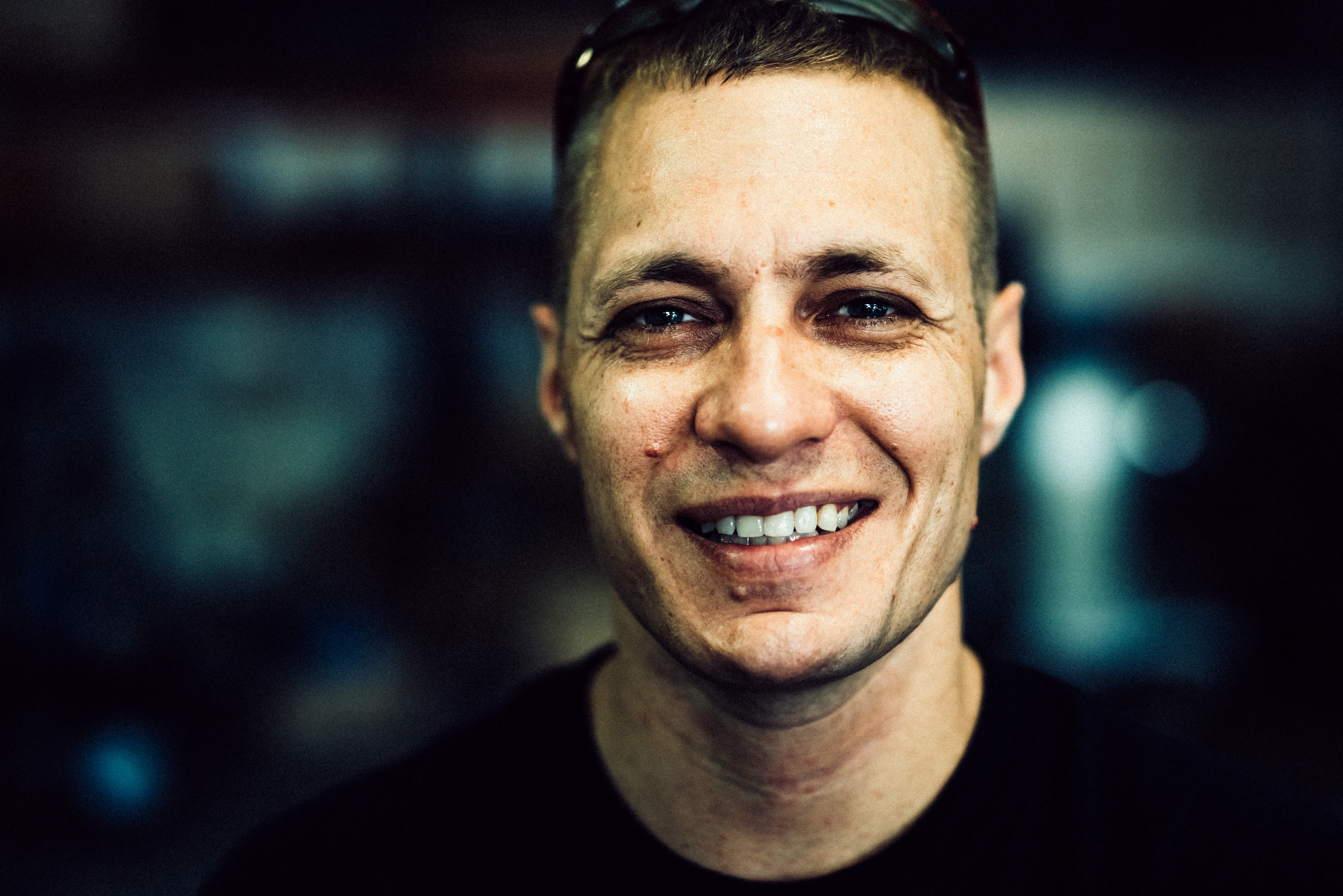
Road to Redemption
It was Feb. 1, 2002, and Sal D'Angelo wanted to hide. D’Angelo, a wiry 5 feet, 10 inches tall 21-year-old with tattoos of a cross on his right leg and a wizard on his right arm, had just been released after 16 months in Lancaster Correctional Institute in Trenton, Florida, and another year in a Hillsborough County jail. His mother had picked him up and brought him to her home in Tampa. But instead of being elated, he was terrified. “I didn’t want to get out of the house,” he says. “I was scared to go back into society.”
Lancaster had been a nightmare, he says, a “gladiator camp” where brawls broke out between squads of prisoners segregated according to their hometowns. And the violence wasn’t limited to the prisoners. On the bus to prison, a guard cracked D’Angelo in the face for sticking the tip of his toe into the aisle.
By age 13, D’Angelo was already what he calls a “full-blown addict.” He was born in Far Rockaway, New York, a rough section of Queens that was home to gangs divided along racial lines. D’Angelo’s father was an alcoholic. His mother was addicted to crack cocaine. As a teenager, D’Angelo used cocaine, PCP, angel dust and ecstasy. “I took a super-nose-dive right into the streets,” he says. “There was nowhere else to go.”
He says drugs also helped him kill the shame of sexual abuse. When D’Angelo was 10, an older cousin began molesting him, and he had no one to turn to. D’Angelo’s mother had moved to Tampa and left him with his father, who drank all day in his auto repair shop and brought D’Angelo with him to bars. D’Angelo served as a “beer boy,” fetching drinks for his father and his pals and munching on the cocktail fruit in the trays behind the bar.
His father eventually got sober, but when D’Angelo began stealing to buy drugs, his father sent him to live with his mother. In Tampa, D’Angelo’s habit grew worse. Stealing bikes from back porches and golf clubs from garages led to more serious crimes.
On Nov. 16, 1999, D’Angelo was behind the wheel of a red Ford Probe when a friend reached out and snatched a purse from a woman in a Walmart parking lot. D’Angelo accelerated, and the pair escaped with $448 in cash and goods. Twelve days later, they repeated the crime, this time in a Publix parking lot, making off with $230. Arrested two weeks later, D’Angelo was charged with strong-arm robbery, burglary, grand theft and dealing in stolen property. He went to prison the next year.
After he was released, he says, “I wanted to do good. I wanted to be a good person.”
But he didn’t have the courage or the guidance to cut ties with old friends. He hadn’t told his buddies he was coming home, but they heard the news; and when they came around a week later, they wanted to celebrate, which meant getting drunk and getting high. D’Angelo made it five months before being arrested again.

More than 2.2 million Americans are currently incarcerated
Image: Shutterstock
America locks up more of its citizens than any other country on earth. Home to 4.4 percent of the world’s population, the United States is also home to 22 percent of the world’s prisoners, a population that has increased fivefold in the last 40 years. More than 6.7 million Americans, one out of every 37 citizens, are under some type of correctional control, and more than 2.2 million are in a state or federal prison or local jail.
Almost all of them will at some point get out. Each year, 650,000 people are released from federal and state prisons. In an average week in Sarasota County, five people are coming home from a stint in prison and seven are returning to Manatee County.
Once home, they face daunting hurdles. Many owe court fees and must make restitution payments, and they’re vulnerable to credit scams and predatory loans. In Florida, anyone convicted of drug trafficking can’t receive welfare benefits and food stamps, while felons with drug or violence convictions within the past five years can’t get help through the Sarasota Housing Authority’s voucher program or live in public housing. All felons in Florida lose the right to vote.
Such restrictions are known as “collateral consequences,” and there are more than 1,200 such consequences on the books in Florida alone. They disproportionately affect minorities. In Florida, 48.1 percent of prison inmates are black, while blacks make up just 16.8 percent of the state’s population.
And along with all the consequences of imprisonment, many criminals are ill-equipped to compete and succeed in society. “Many people enter prison with educational deficits, as well as limited or sporadic employment histories, housing instability and mental health and substance abuse issues,” says Janeen Buck Willison, a senior fellow with the Justice Policy Center at the Urban Institute in Washington, D.C. Addressing the “multitude of those needs” is critical for successful re-entry, she says, but most former prisoners “have tenuous social support.”
Often unable to afford to live on their own, newly freed individuals frequently turn to friends and family for help, but those relationships may be dysfunctional. And many ex-prisoners return to the neighborhoods where they committed their crimes, places where harsh memories and temptation lurk.
It’s also hard for former prisoners to find work. One study found that white job applicants with criminal backgrounds are 50 percent less likely to get called back for an interview than those with similar credentials but no criminal record; black applicants with criminal backgrounds are 64 percent less likely to be interviewed. Some ex-cons are hired by day labor firms or lawn maintenance companies, but most struggle to find a position that will give them a path forward. In addition, many landlords refuse to rent to applicants with felony convictions.
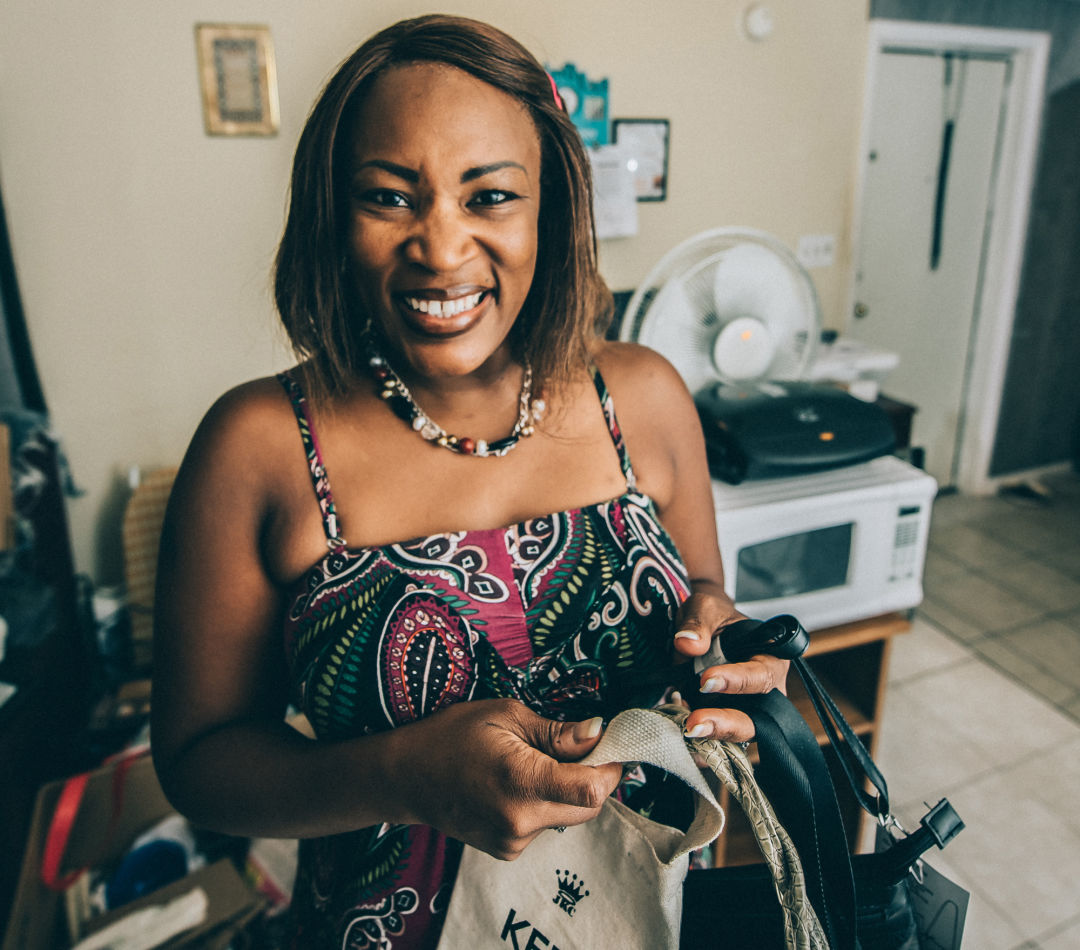
After her release from prison, says Tammica Summers, “I was drowning in freedom.”
Image: Everett Dennison
Tammica Summers, 44, spent almost 12 years locked up for her role in a 2002 murder. Summers was working as an escort when her boyfriend beat one of her clients to death. Her first days out were difficult. “I was overwhelmed with freedom,” she says. “It was drowning me. I had figured out a way to do time. But I had to figure out a way to be free again.”
The only home Summers could find was at a Bradenton motel that rented by the week, and when she applied for a job at a car wash, she was rejected. “That’s a blow, when a car wash doesn’t want you,” Summers says. “All they see is someone convicted of murder.” She worked in the adult entertainment business, then got a job at Dunkin’ Donuts. Summers eventually saved up enough to purchase a trailer and worked at a Goodwill Manasota store. She recently opened a flea market stall selling beauty products.
But she still feels the stigma. Summers often uses a fake name so new acquaintances can’t Google her. She is estranged from her three children and she feels isolated. “I don’t associate with anyone. I’m paranoid. I can understand why a lot of people get the thought, ‘I might as well go back to prison,’” Summers says.
Even charges that don’t result in time served can have lasting consequences. When he was 18, Bradenton’s Tim Swart stole two golf carts. Charged with two felony counts of grand theft of a motor vehicle, he was sentenced to probation and 50 hours of community service.
The crimes still follow him. Through a temp agency, Swart was working maintenance at an apartment complex. After a year, the complex owners wanted to hire him, which would have given him a full-time position and higher pay. But when they learned about his criminal background, they explained the complex’s rules prohibit hiring people with criminal convictions. “It screwed me out of a job,” says Swart, now 24. “It was pretty much a flat, ‘No, we can’t do it.’”
The world changes while you’re locked up. Summers received text messages on the cell phone she got after being released, but she broke down in tears because she didn’t know how to send a message back. Former prisoners struggle with using the internet to search for jobs and even basic activities like activating automated sinks in public restrooms and choosing what food to eat after years of meals selected and prepared by others.
Over 52 percent of Americans released from prison are arrested again within eight years, and in Florida, 47 percent of prisoners are behind bars for the second, third, fourth or even fifth time. All those additional charges mean additional victims, and recidivism also adds to the state’s financial burden. Florida spent $1.9 billion on prisons in 2015—$19,069 per inmate, or $95 per Florida resident.
In Sarasota, a handful of social programs assist newly released offenders. One committed to the mission is Project 180, a nonprofit founded in 2008 by Barbara Richards.
Richards spends most days in a nondescript office donated by the chemical company SimChem, answering calls from newly released individuals and their family members. The nonprofit also organizes an annual lecture series on criminal justice topics, and its volunteers, including bankers, restaurateurs, day labor managers and career counselors, travel with Richards to nearby prisons to teach job-search basics and lead financial literacy classes in the Sarasota County jail.
Project 180 classes are informative, even upbeat and inspiring. The inmates are quick to laugh, and they ask sharp questions about how to handle car payments, how to explain a criminal history to a potential employer and whether you must pay income tax on the money that goes into your 401(k). Susan Brothers, a Sarasota branch manager with Iberia Bank, teaches the basics of saving and investing at the Sarasota County jail. “Of all the volunteer work I’ve ever done,” she says, “I feel like I’m giving back the most here.”

Image: Shutterstock
Many former prisoners also struggle with addiction. One study found that almost 50 percent of current inmates are clinically addicted, and about 18 percent of inmates say they committed their crimes to get money for drugs. That ratio is higher for those arrested in Sarasota, says Sarasota County Sheriff Tom Knight: “Most of our crime is fueled by addiction.”
When D’Angelo was arrested in 1999, he signed up for an Alcoholics Anonymous and Narcotics Anonymous rehabilitation program to lessen his sentence, but the program didn’t stick. Neither did a 28-day program in upstate New York where his father had finally gotten clean. The truth, he now says: He didn’t want to get help.
After getting out in 2002, he started selling drugs and stealing to finance his next high, and the crimes began to pile up, from marijuana possession and traffic violations to an open container misdemeanor that led to an arrest because he skipped his arraignment. In 2008, he was arrested in Sarasota while pushing a cart filled with $30 worth of stolen aluminum down the road. Charged with burglary, he didn’t show up for his court date and was arrested again. When not in jail, D’Angelo lived in the streets and flopped at crack houses.
“Drugs make you not care about nothing,” D’Angelo says. “You just want more, more, more. You’ll steal out of your mom’s purse. You’ll snatch an old lady’s purse. It just takes over your mind and your soul.”
In 2009, D’Angelo overdosed near a Sarasota trailer park and collapsed in a ditch. When he woke up in detox, he knew he needed to change his life. But the realization was short-lived. He spent another year smoking crack and ingesting prescription pills.
D’Angelo remembers the exact date of his most recent arrest, the one he swears is his last: June 10, 2010. He was picked up at JCPenney while trying to buy clothes with a stolen credit card; the employee who called the cops reported that D’Angelo was “acting erratically.” The Sarasota County deputy who responded found D’Angelo in the men’s section with an armful of clothes. He was twitching, and his pupils were tiny pinpoints. His weight had dropped from 160 pounds to 145. When the officer searched him, he found marijuana and nine Oxycodone pills. D’Angelo told the deputy he had bought the pills for $15 a pop from “a guy in a Mustang.” He had also smoked crack earlier that day. After he was arrested, D’Angelo picked up an additional charge for selling five Roxicodone pills to an undercover cop for $75 earlier that year.
People often told D’Angelo he’d be dead by 30. This time, he was determined to prove them wrong. He enrolled in a Sarasota County jail recovery program and moved into pod 5000 on the fifth floor. D’Angelo lived with 47 other male inmates committed to getting sober in a large room, with two tiers of cells overlooking an open area dotted with tables where the men, dressed in loose-fitting corrections-orange uniforms with “JAIL” printed on the right leg, would gather for intense sessions structured around the 12-step process. (A separate pod, pod 6000, works with 48 female inmates at a time.)
The program dug deeper than any previous program D’Angelo had tried. He filled hundreds of pages with reflections about his life, unearthing childhood memories as well as documenting his years behind bars. “I started learning about what I had to change and who I really am,” he says. “I was 29 years old. I’d been on the streets my whole life. You have to start your whole life over and forget everything you’ve ever known. It’s not simple.” D’Angelo had always believed in God, prayed regularly and had even been baptized in prison, but recovery made his faith stronger.
After he was released, D’Angelo signed up for the Salvation Army’s Voluntary Interim Placement–Enhanced Recovery Program. He lived at the Salvation Army for five months, with three meals a day and access to doctors, counselors, dentists and pastors. After that, he lived in halfway houses and got a job waving a sign on the side of a street in the middle of summer, wearing a backpack stuffed with water bottles to survive the heat. “I winged it,” he says. “I did what I had to do.”
He had to pay thousands of dollars to the county before he could get a driver’s license, so he rode a bike and took the bus for almost two years. He moved through the same streets he had passed through as an addict. He ran into old friends and turned away without saying anything. “I felt like an alien,” he says.
In 2011, when a halfway house D’Angelo was living in fell apart, he didn’t know what to do next. A friend suggested he call Adam Bollenbach, the parts and service manager at Custom Carts, a business that builds and sells specialty golf carts. D’Angelo’s father was an auto mechanic, and when D’Angelo was young, he would sit and watch his father work on cars every day. For D’Angelo, putting together a golf cart was like playing with Legos.
Bollenbach, a former addict with a rap sheet of his own, has a reputation for hiring men struggling with addiction. When Bollenbach met him, D’Angelo was in the early stages of recovery, twitchy and unsure of himself, but Bollenbach gave him a job. Bollenbach says that less than half of the ex-cons and recovering addicts he hires work out. Giving D’Angelo a chance was a gamble.
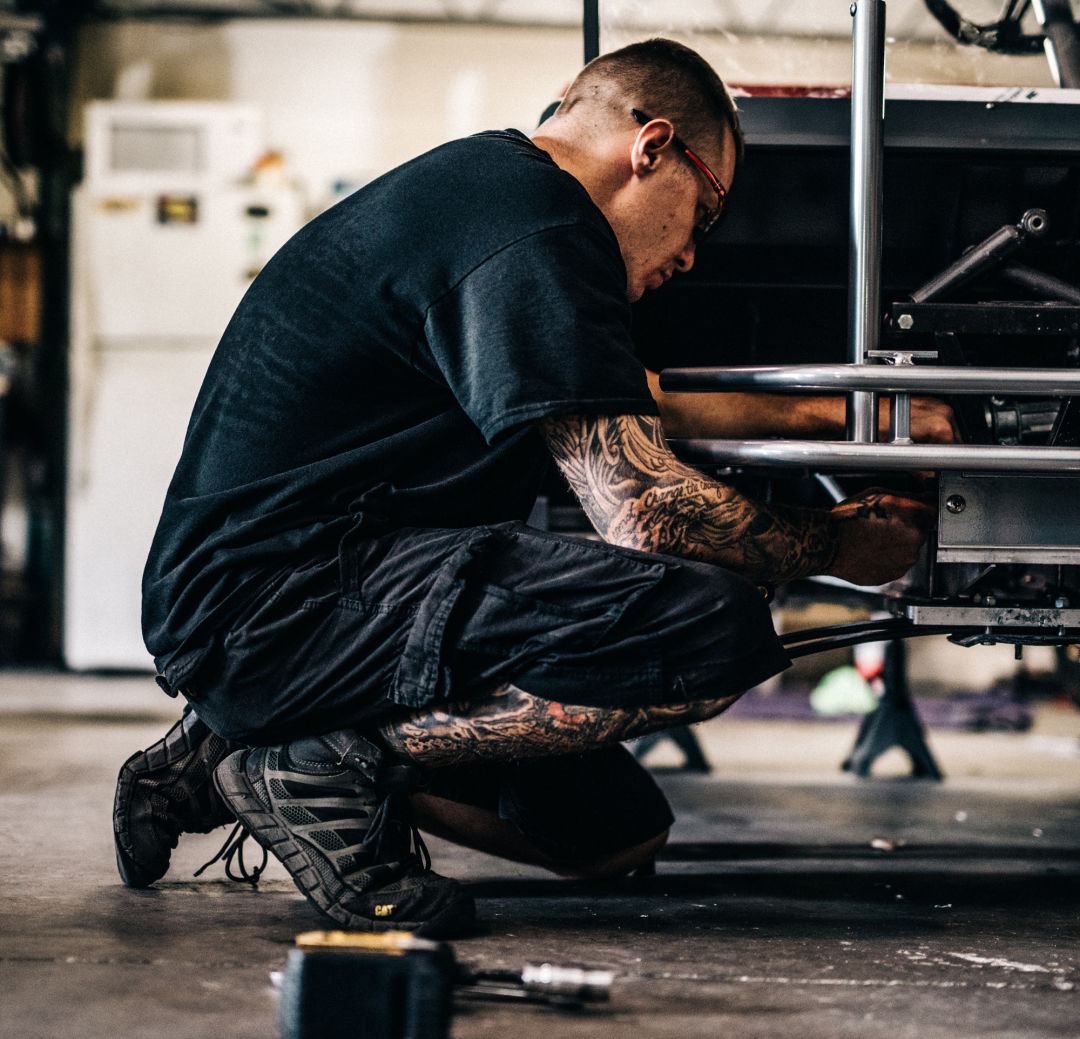
D’Angelo leads a crew of workers building golf carts at Sarasota’s Custom Carts.
Image: Everett Dennison
If you ran into Barbara Richards, you’d never guess she spends much of her time in prisons and with ex-cons. A slight woman with close-cropped white hair and thin wire glasses perched on her nose, she dons stylish dresses and suits for meetings. Richards, who’s in her 60s, is amiable, but she’s also intense and determined. Someone once called her “silent but deadly,” a description she relishes.
Project 180 is creating a residential program that will house released offenders in a sober setting, with job connections, classes and volunteer work. The program is modeled on a similar program in California, the state where Richards first stepped inside a jail.
It wasn’t where she thought she’d end up. Born in Tulsa, Oklahoma, Richards attended Iowa’s Grinnell College for three semesters before traveling to West Africa to visit her sister, who was in the Peace Corps. The experience inspired Richards to drop out of college and take off with $300 and a one-way plane ticket. She spent a year in Australia and eventually moved to San Francisco. In California, she worked in the restaurant industry, got married and gave birth to two daughters. After a divorce, she went back to school and earned her bachelor degree. In 1997, she heard an NPR report about the low educational level of most prisoners. Today, 37 percent of Florida prisoners are reading at or below a fifth-grade level, and 71 percent are reading at or below a ninth-grade level.
“It was like having God tap me on the shoulder and say, ‘Wake up. This is your work. Get busy,’” she says.
She vowed to begin working with inmates, but she was afraid. On the day she was set to interview for a job running an incarcerated men’s support group, she pulled up to the gates at a jail in San Bruno, just south of San Francisco, looked at the towering buildings filled with inmates, and turned around and drove to a grocery store instead. She thought she couldn’t do it, but while pushing the cart around the store, she resolved to try. She drove back and got the job.
Richards was told the men would either accept or reject her within the first few minutes. “They were kind enough to accept me,” she says, “and they were amazing, amazing people who, if they had been born into any other community or family or circumstance, would have been professionals, CEOs, teachers, attorneys, physicians. They were smart, funny, engaged.” Richards brought in readings that ranged from Plato to current psychology, talking with the inmates about how the words related to their own lives and time behind bars.
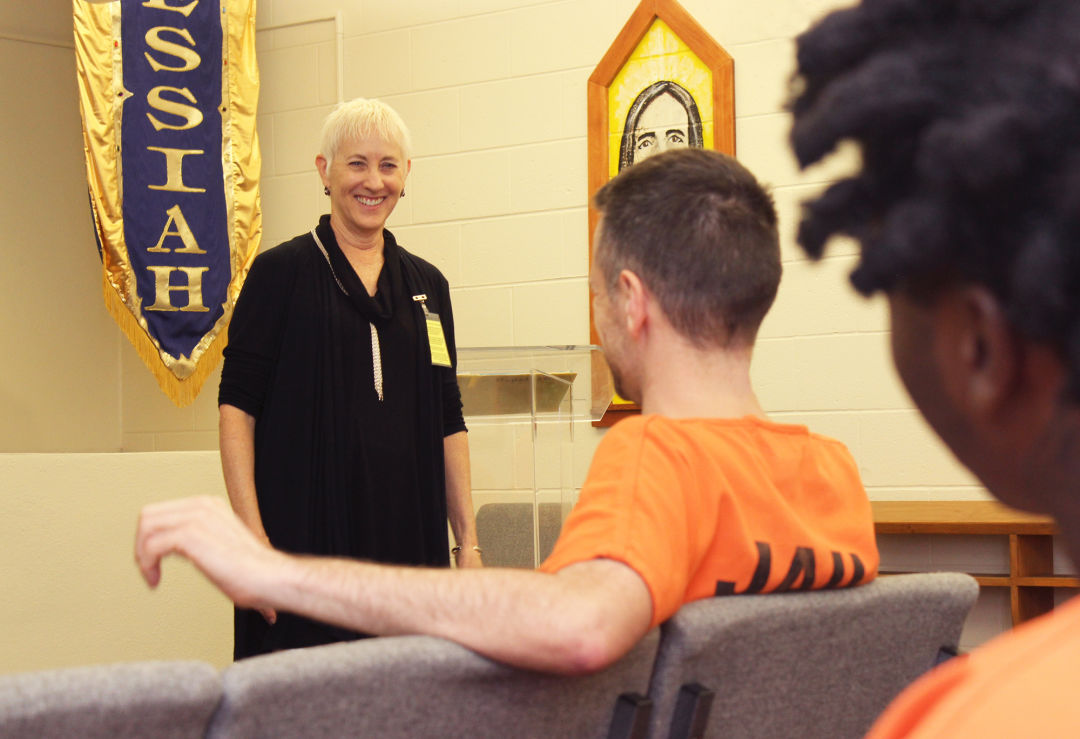
Barbara Richards helps lead a financial literacy class inside the Sarasota County jail.
She later got a full-time job running GED and adult education classes in other jail settings. One thing nagged: She kept seeing the same faces. Drug addiction “had a stranglehold on people,” she says. “These folks had no resources, and they went back to the street once they got out.” Richards decided to go back to school. She enrolled in Florida State University in 2004, studying the psychological impact of incarceration and the role of employment in rehabilitation.
After she graduated in 2006, she wanted to launch an offender re-entry nonprofit in Florida, home to only a few such programs. She moved to Tampa, but the arts and culture of Sarasota persuaded her to move south. Project 180 was incorporated in 2008.
Building the nonprofit—the arduous task of raising money, recruiting board members and volunteers—has taken time. Convincing people to support programs for felons is tougher than selling them on cuddlier causes. Project 180’s annual revenue in 2016 totaled only $123,000.
The new program represents a significant step forward. An anonymous Sarasota businessman is purchasing a home and leasing it to Project 180. The facility will house six recently incarcerated individuals for two years, with a rotating staff of three, who will live with the offenders and manage the house. Transportation to and from work will be provided, and addiction recovery services will be integral. Richards believes that to reduce recidivism, our thinking about addiction must change. “Until we recognize addiction as a disease, rather than a choice or a lack of will, we will have a very difficult time turning around,” she says.
Refusing to see this reality incurs great costs, both socially and financially, she says. “We cannot incarcerate our way out of social issues, and to try to do so is going to bankrupt state and local governments,” Richards says.
Many officials in the criminal justice system are concerned about the Trump administration’s “tough-on-crime” rhetoric and the possible return of harsh sentences and policies that they say have been shown not to work. But Richards remains optimistic. “More and more, people are rejecting the idea that everybody who has been through the system needs to be thrown away,” she says. “Even though there might be individuals who want to turn back the hands of time, just about everybody [else] knows that it is not a viable method of accomplishing what we all want, which is a safe community in which every individual has the opportunity to thrive.”
Knight also sees a “fundamental shift” in how America grapples with crime. “We’re tough on crime,” he says of his office, “but we’re also OK with helping people.” If parenting and financial literacy classes and addiction recovery services prevent future crimes from being committed, why shouldn’t jails offer them? Knight calls his jail’s approach the “pragmatic” one. “I truly believe it’s the future of incarceration,” he says.
On work days, D’Angelo, now 36, rises around 6:20 a.m. to make coffee. He has stayed lean, but the number of tattoos on his body has grown. Most are a testament to his faith, with depictions of Jesus and Calvary, rosary beads made out of the Serenity Prayer and a scroll emblazoned with Proverbs 28:1—“The wicked run while no one is chasing them, but the godly stand bold as lions.” A dragon symbolizes strength, a microphone references a passion for Christian rap and a Japanese koi fish swimming upstream portends good luck.
D’Angelo shares an apartment with his 31-year-old girlfriend, Erin Babich, now eight months pregnant with the couple’s first child. (D’Angelo also has a 5-year-old son and a 7-year-old daughter from previous relationships. Babich has a 10-year-old daughter.) The couple lives on the second floor of a two-story building in a small complex on Fruitville Road, the kind of place where the outdoor light fixtures are busted and where residents keep their blinds closed and doors locked even when they’re home.
They say they didn’t bother searching for something better, because they knew they’d be shut out. “People think once you’re a criminal, you’ll always be a criminal,” D’Angelo says. But D’Angelo and Babich have fixed up their apartment nicely, with a glass dining room table, woven placemats and art etched with inspirational quotes on the walls.
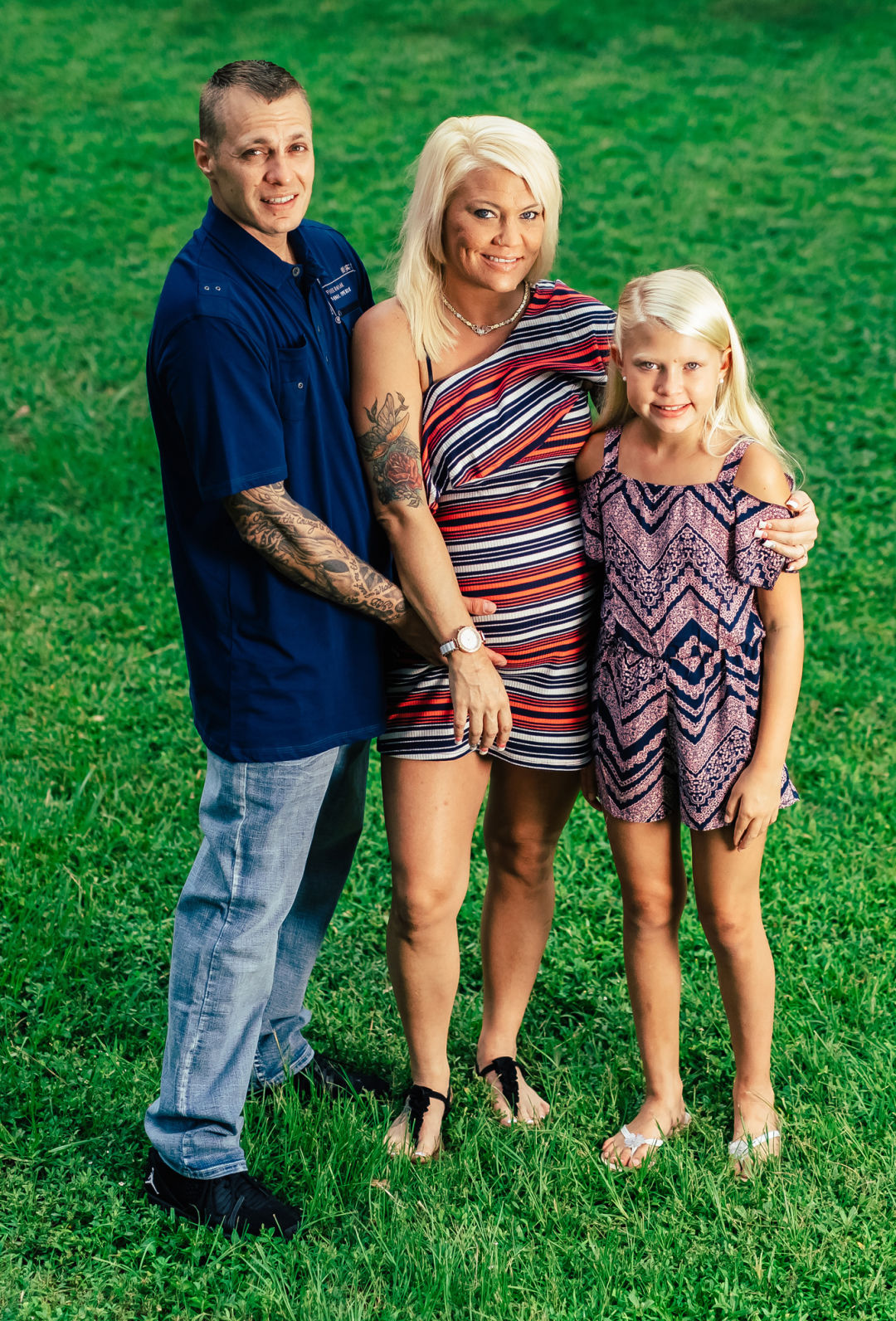
D’Angelo, Erin Babich and her daughter.
Image: Everett Dennison
Babich spent six months in prison last year; she met D’Angelo at an AA meeting. D’Angelo remains active in recovery programs, chairing meetings and sharing his story and rapping about his experiences and his faith. He visits churches and detox facilities to talk with recovering addicts. “When someone asks me to speak or share, I feel like I’m not doing what I’m supposed to be doing if I tell that person, ‘No,’” he says.
That includes speaking at Project 180 events. In May, D’Angelo participated in a lunchtime panel discussion that raised money for the nonprofit. Project 180 didn’t exist when he got out of prison in 2002; if it had, perhaps it might have helped.
D'Angelo, along with formerly incarcerated individuals Terrance Blake and Deanna Zappi, spoke about their experiences in prison during a Project 180 panel discussion held in May and filmed by Manatee Educational Television
At 6:50, D’Angelo is out the door, driving to Custom Carts, where six years after being hired, D’Angelo now leads his own shop, with a crew of three to four workers. To make money on the side, he picks up extra work on golf carts, repairs cars and trucks and rescreens pool cages.
“He went through a lot of shit,” Bollenbach says. “He had child support stuff, girlfriend issues, and he just kept plugging away. He always showed up, always went to meetings, and he stayed.” Working alongside fellow employees going through recovery helped. Bollenbach says people are more likely to relapse when their colleagues are hanging out after hours smoking marijuana and drinking.
But despite a steady job and growing family, life for D’Angelo remains precarious. He can’t afford health insurance, and in July 2016, a car rear-ended his vehicle, which put him out of work for four weeks. “I lost everything,” he says. “I’m $50,000 in debt and I live check to check.” His phone buzzes regularly with calls from debt collectors.
“Right now, I’m struggling really bad,” D’Angelo says. “I’ve got $6 in my bank account. I’ve got about $150 in my pocket. That’s my whole life savings.” He’s cut his bills to the basics, and takes life day by day. Dreams of owning his own business are, for the moment, just that—dreams.
But whatever obstacles he faces today, he insists the past is the past. “Nothing will ever make me go back to the streets or get high or drink again,” D’Angelo says. “I’m done.”